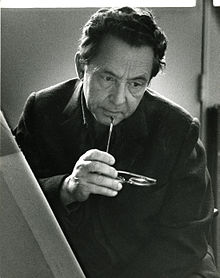Hans Hartung
Hans Hartung | |
|---|---|
 Hans Hartung, photo byPaolo Monti,1960 (Fondo Paolo Monti,BEIC) | |
| Born | 21 September 1904 |
| Died | 7 December 1989(aged 85) |
| Nationality | German-French |
| Movement | Tachism,Lyrical Abstraction |
| Awards | Venice BiennaleGrand Prix |
Hans Hartung(21 September 1904 – 7 December 1989) was a German-French painter, known for his gesturalabstractstyle. He was also a decoratedWorld War IIveteran of theLegion d'honneur.
Life
[edit]Hartung was born inLeipzig,Germany, into an artistic family. He developed an early appreciation ofRembrandt,German painters such asLovis Corinth,and theExpressionistsOskar KokoschkaandEmil Nolde.In 1924, he enrolled in Leipzig University, where he studied philosophy and art history.[1]He subsequently studied at the Fine Arts academy ofDresden,where he copied the paintings of the masters. The modern French and Spanish works he saw in 1926 at the Internationale Kunstausstellung in Dresden were a revelation to him,[1]and he decided that he would leave his native country to prevent succumbing to provincialism. Consequently, after a bicycle trip through Italy, he moved toParis.
In Paris, Hartung had little contact with other artists and copied the works of old and modern masters. He visited the south of France, where the landscape inspired him to a close study of the works ofCézanne,and he developed a great interest in principles of harmony and proportion such as thegolden section.[1]In 1928 he visitedMunichwhere he studied painting technique withMax Doerner.In 1929, he married the artistAnna-Eva Bergmanand established himself in the French towns ofLeucate,and then in theSpanishBalearic Islands,eventually settling inMenorca.He exhibited for the first time in 1931 in Dresden.

The death of his father in 1932 severed Hartung's last bonds with Germany. He was rejected from Nazi Germany on account of being a 'degenerate', because his painting style was associated withCubism– an art movement incompatible with Nazi Germany's ideals. In 1935, when he attempted to sell paintings while visiting Berlin, the police tried to arrest him. He was able to flee the country with the help of his friendChristian Zervos.
After he returned to Paris as a refugee, Hartung and his wife divorced, and he became depressed. His paintings were becoming more abstract and did not sell well. His friends tried to help him with his financial difficulties, and the sculptorJulio Gonzálezoffered him the use of his studio. In 1939 Hartung married González's daughterRoberta.[1]
In December 1939, he became a member of theFrench Foreign Legion.He was closely followed by theGestapoand arrested for seven months by the French police. After they learned he was a painter, he was put in a red cell in an attempt to disturb his vision. After being released he rejoined the Legion to fight inNorth Africa,losing a leg in a battle nearBelfort.He earned French citizenship in 1945, and was awarded theCroix de Guerre.
In 1947, in Paris he had his first solo exhibition. By the late 1950s, he had achieved recognition for his gestural paintings, which were nearly monochromatic and characterized by configurations of long rhythmical brushstrokes or scratches. In 1960, he was awarded the InternationalGrand Prixfor painting at theVenice Biennale.[2]In 1957, Hans Hartung was the first painter to receive the Rubens Prize of the City of Siegen.[3]
Hartung's freewheeling abstract paintings set influential precedents for many younger American painters of the 1960s, making him an important forerunner of AmericanLyrical Abstractionof the 1960s and 1970s. He was featured in the 1963 film documentarySchool of Paris: (5 Artists at Work)by American filmmakerWarren Forma.
In 1957, Hartung and Anna-Eva Bergman remarried. He died on 7 December 1989, inAntibes,France.
See also
[edit]Notes
[edit]- ^abcdAlley, Ronald, "Hans Hartung", Oxford Art Online
- ^"Untitled Document".Archived fromthe originalon 2007-09-27.Retrieved2007-06-15..accessed on line June 15, 2007
- ^Exhibition: Hans Hartung and the Photography (2017)https://www.mgksiegen.de/en/ausstellungen/457/hans-hartung
References
[edit]- La mort de Hans Hartung Le peintre, pionnier puis classique de l' "abstraction", est mort, vendredi 8 décembre, à l'âge de quatre-vingt-cinq ans,Le Monde. Lundi 11 décembre 1989, p. 1. accessed on October 8, 2006.
- Müller-Yao, Marguerite Hui:Der Einfluß der Kunst der chinesischen Kalligraphie auf die westliche informelle Malerei,Diss. Bonn, Köln 1985.ISBN3-88375-051-4
- Müller-Yao, Marguerite:Informelle Malerei und chinesische Kalligrafie,in:Informel, Begegnung und Wandel,(hrsg von Heinz Althöfer, Schriftenreihe des Museums am Ostwall; Bd. 2), Dortmund 2002,ISBN3-611-01062-6
- Rolf Wedewer:Die Malerei des Informel. Weltverlust und Ich-Behauptung,Deutscher Kunstverlag,München, 2007.ISBN3-422-06560-1
External links
[edit]
- 1904 births
- 1989 deaths
- Abstract expressionist artists
- Cubist artists
- 20th-century French painters
- 20th-century German male artists
- French male painters
- 20th-century German painters
- German male painters
- Modern painters
- Artists from Leipzig
- School of Paris
- Painters from Paris
- Soldiers of the French Foreign Legion
- Recipients of the Croix de Guerre 1939–1945 (France)
- French military personnel of World War II
- Members of the Académie des beaux-arts
- Art Informel and Tachisme painters
- French amputees
- French artists with disabilities
- Emigrants from Nazi Germany to France
- Knights Commander of the Order of Merit of the Federal Republic of Germany
- Recipients of the Pour le Mérite (civil class)
